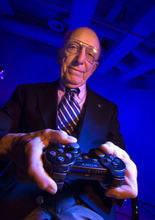This is an archived article that was published on sltrib.com in 2011, and information in the article may be outdated. It is provided only for personal research purposes and may not be reprinted.
Ralph H. Baer is the man you either thank for countless of hours of entertainment or the man you blame for your kids' failing grades and your husband abandoning you to play "Call of Duty."
The television engineer and now 89-year-old "Father of Video Games" invented the first home video game console, the Magnavox Odyssey, in 1972 — five years before the Atari 2600 took America by storm.
In fact, Baer created the precursor to the Odyssey clear back in 1967. The "Brown Box," a unit with corded controllers that had a number of games built in, including a ping-pong game similar to the legendary "Pong" that University of Utah graduate and Atari president Nolan Bushnell created five years later.
Today, the average gamer spends eight hours a week feeding an $18.5 billion-a-year business that reaches 67 percent of American households.
Even Baer couldn't foresee the monster his ingenuity and engineering prowess would unleash.
"Could I project how far this thing was going to go? The answer's obviously no.Nobody realized, even at that time, that we were on this geometric curve ... that would go straight up to heaven," Baer, of Manchester, N.H., said last week while visiting Salt Lake City to receive this year's Cyber Pioneer Award during the Utah Cyber Symposium. "It was unforeseeable; it was fantastic. I'm glad it happened. And if I hadn't had started it, someone else would have."
But it was Baer in the mid-1960s — while working for defense contractor Sanders Associates — who first came up with the idea of using a home television set for electronic gaming.
The German-born engineer, who graduated from the American Television Institute of Technology in Chicago thanks to a G.I. Bill, had his "Magna Carta moment" in which he wrote a four-page paper on Sept. 1, 1966, detailing the concept of the first video game.
"I knew how television sets worked because I designed and built them. I knew how studio equipment works. I knew how the transmitter works. I had used test equipment that creates bars and rectangles on the screen. So putting stuff on the screen was no mystery. It was natural. But doing something with it, that was the 'eureka,'" he said.
Actually, it was MIT student Steve Russell who produced the first known video game, a computer hack he called "Spacewar" on a Digital Equipment Company PDP-1 computer at the college's electrical engineering department. But Baer, who said he was unaware of "Spacewar" at the time, envisioned a game he could market to the 40 million U.S. television owners.
Starting with that idea, he developed a series of prototypes that eventually led to his legendary "Brown Box," a set top box in an aluminum casing that he wrapped in a cover designed like wooden paneling. Inside it were two dozen games, including a golf game, ping-pong game and football. (Baer also could be credited as the first person to lose in a home video game, being defeated in ping-pong by a fellow technician.)
In 1971, while Baer still worked for Sanders, the technology for the "Brown Box" was sold to television manufacturer Magnavox, and the Odyssey was born. It was first demonstrated in the first half of 1972 (where it was first seen by Atari's Bushnell before he marketed the first "Pong" arcade machine) and Magnavox began selling it in May of that year.
"I was a young kid back then and beating my brother [in the game]," Baer's son, Mark, remembered about playing the Odyssey for the first time.
Ultimately, the Odyssey sold 325,000 units, not the huge success that Atari would have with its 2600 gaming console five years later, in large part because it would only work with Magnavox televisions.
Baer, who lives in Manchester, N.H., has since continued on as a video game and toy inventor. He also invented the famous "Simon" memory game, and he developed the first video game peripheral — a light gun you could use for shooting games. And in the late 1980s, he developed a motion controller for the Nintendo NES system that involved placing a motion camera on the TV that could detect the player's light gun and movement, a precursor to today's Nintendo Wii motion game and Microsoft's Kinect peripheral. Back then, Nintendo turned down his idea.
Today, Baer's contributions to the video game industry are well recognized. His Brown Box now sits in the Smithsonian Institution's National Museum of American History, and he has received the National Medal of Technology from President George W. Bush as well as lifetime honors from the Consumer Electronics Association (just last week) and the Institute of Electrical and Electronics Engineers. Last year, he was inducted into the National Inventors Hall of Fame.
"We're proud, and my siblings are proud, and my kids are proud because it's a pretty unique story," said Mark Baer, a prosecutor for the Utah Attorney General's Office.
While Baer, too, is proud of his contribution to the burgeoning video game industry, he also has some regrets about what he has brought forth as a new medium of entertainment — mainly the way some video games have turned violent.
"I think it's a disgrace," he said coincidentally just a few days before the popular shooter "Modern Warfare 3," hits stores. That game is projected to be the biggest-selling video game of the year and perhaps of all time. "What I created got abominated. You can see the same thing in music, literature, art — any form of art," he added.
But warts and all, Baer has created something that has revolutionized the way people are entertained and how they interact with their television. It's an accomplishment that even he has a difficult time grasping.
"All I did was come up with what I thought was a fun idea that was the result of a little box that was attached to a television set," the elder Baer said. "It just grew and grew and grew."
vince@sltrib.com
Twitter: @ohmytech
Google+: +Vincent Horiuchi





